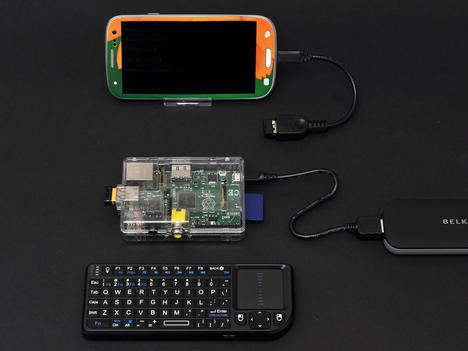Build a Portable Android-based Raspberry Pi Station

Productivity Sauce
Transforming a bare-bones Raspberry Pi into a fully-functional portable station is a popular pastime among enterprising users, and you can easily find instructions on how to build a Kindleberry Pi, a Kindleberry Wireless, and even a Raspberry Pi Linux laptop. But if you happen to use an Android device, you can opt for a less complicated and more modular solution devised by yours truly.
The Android device in this setup acts both as a wireless hotspot and a display for Raspberry Pi. The latter is configured to automatically connect to the Wi-Fi network created by the Android device. And an SSH client app (e.g., VX ConnectBot) running on the Android device is used to access Raspberry Pi via an SSH connection. Here is what you need for this project:
- Android device with wireless hotspot functionality
- An SSH client app like VX ConnectBox installed on the Android device
- OTG (On-The-Go) micro-USB cable (not required for use with a Bluetooth keyboard)
- Wireless mini keyboard with integrated touchpad like the one from Rii
- Wi-Fi USB dongle known to work with Raspberry Pi (e.g., Edimax EW-7811Un)
- Optional external battery pack for powering Raspbery Pi
Start with connecting the keyboard to the Android device using the OTG micro-USB cable. Alternatively, you can use a Bluetooth keyboard which eliminates the need for the cable and makes the entire setup even more elegant. Enable then the wireless hotspot feature. Configure Raspberry Pi to automatically connect to the wireless hotspot. You can do this using the graphical network configuration utility supplied with the Raspbian Linux distribution, or by editing network configuration files by hand. Once you've done that, Raspberry Pi should automatically connect to the wireless hotspot on every boot. On the Android device, find out Raspberry Pi's IP address, then use the SSH client app to establish an SSH connection to it. That's all there is to it. It's also possible to install a VNC server on Raspberry Pi and access its graphical desktop environment using a VNC client on the Android device.
comments powered by DisqusSubscribe to our Linux Newsletters
Find Linux and Open Source Jobs
Subscribe to our ADMIN Newsletters
Support Our Work
Linux Magazine content is made possible with support from readers like you. Please consider contributing when you’ve found an article to be beneficial.

News
-
KDE Unleashes Plasma 6.5
The Plasma 6.5 desktop environment is now available with new features, improvements, and the usual bug fixes.
-
Xubuntu Site Possibly Hacked
It appears that the Xubuntu site was hacked and briefly served up a malicious ZIP file from its download page.
-
LMDE 7 Now Available
Linux Mint Debian Edition, version 7, has been officially released and is based on upstream Debian.
-
Linux Kernel 6.16 Reaches EOL
Linux kernel 6.16 has reached its end of life, which means you'll need to upgrade to the next stable release, Linux kernel 6.17.
-
Amazon Ditches Android for a Linux-Based OS
Amazon has migrated from Android to the Linux-based Vega OS for its Fire TV.
-
Cairo Dock 3.6 Now Available for More Compositors
If you're a fan of third-party desktop docks, then the latest release of Cairo Dock with Wayland support is for you.
-
System76 Unleashes Pop!_OS 24.04 Beta
System76's first beta of Pop!_OS 24.04 is an impressive feat.
-
Linux Kernel 6.17 is Available
Linus Torvalds has announced that the latest kernel has been released with plenty of core improvements and even more hardware support.
-
Kali Linux 2025.3 Released with New Hacking Tools
If you're a Kali Linux fan, you'll be glad to know that the third release of this famous pen-testing distribution is now available with updates for key components.
-
Zorin OS 18 Beta Available for Testing
The latest release from the team behind Zorin OS is ready for public testing, and it includes plenty of improvements to make it more powerful, user-friendly, and productive.

